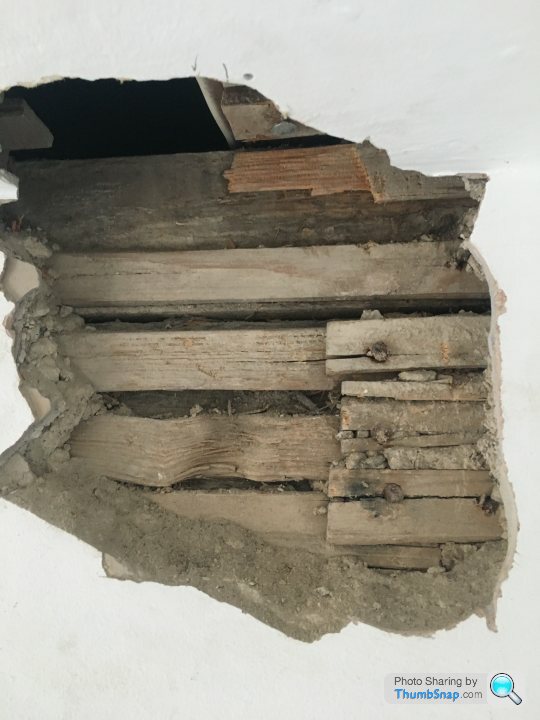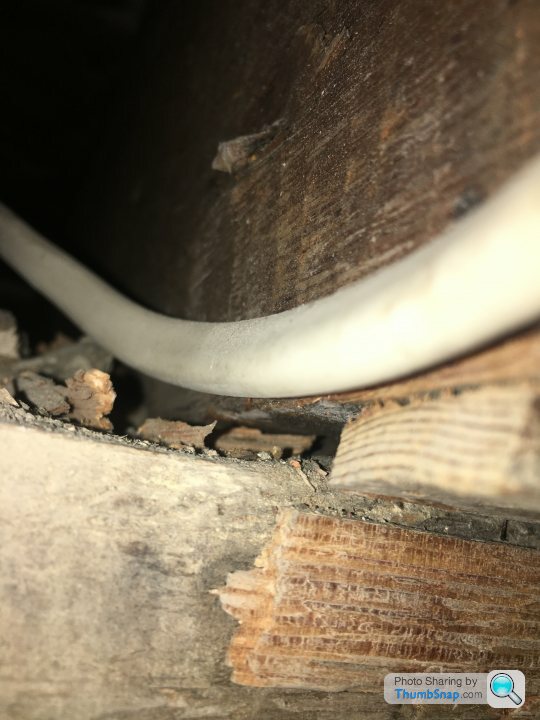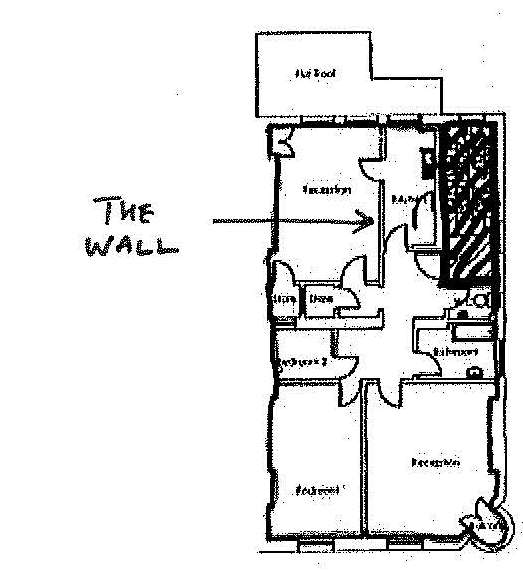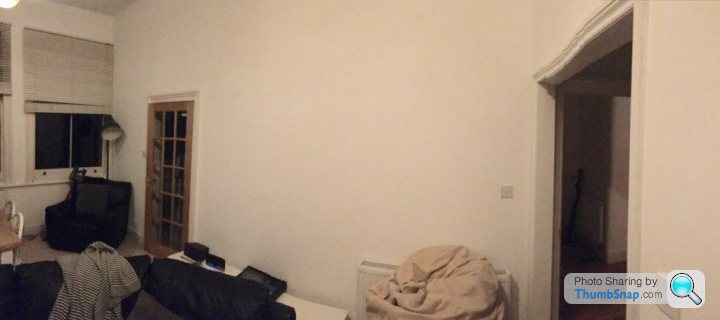Load-bearing lath and plaster wall
Discussion
I'm trying to work out if an internal wall in my flat is load bearing, and thought I'd tap into the wealth of PH knowledge - don't worry, I will check with a structural engineer before I take it out completely!
It's a first floor flat in a relatively old (mid-late 19th century, I think) bank building. There's nothing on the ground floor underneath the wall and, above, there is a parallel wall offset by about a foot or two.
I made a few holes today where the wall meets the ceiling, which confirmed it's a lath and plaster wall. The joist immediately above doesn't appear to be resting on anything in the wall (I could push a knife underneath it without too much difficulty). Normally, I'd be pretty confident it's therefore not bearing any weight, but it's a fairly big span - about 19 feet.
In addition, there were what appeared to be two very chunky horizontal beams running across the top of the wall. I don't know quite how far these extend and don't really have any idea why they're there.
This is what it looks like:


What do you reckon? I'm happy to do more destruction, but didn't know which direction to go to get useful information - and I'd rather leave as little patching up as possible if I do end up not taking the whole thing down!
Any ideas?
It's a first floor flat in a relatively old (mid-late 19th century, I think) bank building. There's nothing on the ground floor underneath the wall and, above, there is a parallel wall offset by about a foot or two.
I made a few holes today where the wall meets the ceiling, which confirmed it's a lath and plaster wall. The joist immediately above doesn't appear to be resting on anything in the wall (I could push a knife underneath it without too much difficulty). Normally, I'd be pretty confident it's therefore not bearing any weight, but it's a fairly big span - about 19 feet.
In addition, there were what appeared to be two very chunky horizontal beams running across the top of the wall. I don't know quite how far these extend and don't really have any idea why they're there.
This is what it looks like:


What do you reckon? I'm happy to do more destruction, but didn't know which direction to go to get useful information - and I'd rather leave as little patching up as possible if I do end up not taking the whole thing down!
Any ideas?
pidsy said:
Neither the lathes or plaster will be load bearing. The weight will be taken by any beams running at the top. You might well find one or two upright beams in the wall spaced to support the top beam. (Kind of like a modern day stud wall)
But wouldn't the joist above then be resting (quite firmly) on the horizontal beam in the wall? If I'm going to take off more plaster to explore, would it be more useful to go along the top of the wall, or down it?samwilliams said:
But wouldn't the joist above then be resting (quite firmly) on the horizontal beam in the wall? If I'm going to take off more plaster to explore, would it be more useful to go along the top of the wall, or down it?
Might be easier to visualise if you knocked up a sketch, but in answer not necessarily...Can you see vertical beams at either end of the wall? The "horizontal" beam going above the one you can see in your photo (I assume that's what you're meaning) will finish off in the same way.
If the span's big enough, you will definitely have other vertical beams embedded on that wall. In fact I'd be surprised if you have more than a 6-8ft span of lathes without another vertical member if my house is anything to go by (though mine's a few hundred years older).
I don't think anyone can make the call if it's loadbearing or not without being there and with out stripping off more plaster. The vertical timber studs will probably be set at 16'' or 18'' centres and if it is loadbearing may have been constructed like this

This design also takes weight off the floor it's sat on. If the building was a bank expect to see carpentry of the highest order under the plaster.

This design also takes weight off the floor it's sat on. If the building was a bank expect to see carpentry of the highest order under the plaster.
Murph7355 said:
Might be easier to visualise if you knocked up a sketch, but in answer not necessarily...
Can you see vertical beams at either end of the wall? The "horizontal" beam going above the one you can see in your photo (I assume that's what you're meaning) will finish off in the same way.
If the span's big enough, you will definitely have other vertical beams embedded on that wall. In fact I'd be surprised if you have more than a 6-8ft span of lathes without another vertical member if my house is anything to go by (though mine's a few hundred years older).
And there was me hoping this would lead to an easy answer! Here are some more diagrams/pictures:Can you see vertical beams at either end of the wall? The "horizontal" beam going above the one you can see in your photo (I assume that's what you're meaning) will finish off in the same way.
If the span's big enough, you will definitely have other vertical beams embedded on that wall. In fact I'd be surprised if you have more than a 6-8ft span of lathes without another vertical member if my house is anything to go by (though mine's a few hundred years older).
This is the floor plan of the flat. I've marked the wall in question. For reference, the wall on the left is a very solid wall (there is a flat next door, but it's actually a separate building). The thick wall going left to right halfway up the floorplan is an old external wall (I believe the rear (top, on the floor plan) half of the building was added on to the front after it was built). And the wall next to the staircase (the shaded bit) appears to be a very solid double brick wall.

This is a diagram of the wall, showing where the hole I made is. As you'll see, it appears that the lath and plaster bit only goes just over halfway along the length of the wall; the rest has a much more hollow sound, and I'm fairly sure is a more modern stud wall construction (whether it existed originally and has been replaced, or is a newer wall, I don't know)

And this is a picture of the wall, in case it's any use (it's probably not!)

My thinking (and I appreciate this is me clutching for reasons why it probably isn't load bearing) is that:
- the three windows along the back of the building are evenly spaced, and the wall I want to remove appears to have been shoe-horned between two of them; that doesn't seem to make sense if that was the original design, which indicates it was a later addition
- the wall next to the staircase seems very solid (from the bit I can see, two layers of bricks). Why would there be a load-bearing wall only about 6 feet in from that
- the joists both in my floor and in the ceiling continue straight across the wall, and it is sitting on the floorboards (and the wall on the floor above which is slightly offset also sits on the floorboards
I know I'm going to have do a bit more excavating before having a proper answer, but where do you reckon I should target my efforts for now?
pidsy said:
is there a chance that the hollow sounding area could have been a doorway at some point?
i'd be aiming for there to see if it has modern timber work in that area or a continuation of the original wall.
It's possible, but I believe it sounds hollow all the way up to the ceiling.i'd be aiming for there to see if it has modern timber work in that area or a continuation of the original wall.
By my reckoning, there are two best bets for the next hole:
- expose the wall further down, immediately below where I've looked so far (to determine what the horizontal beams within the wall are supported by); or
- create a new hole at the point where it seems the lath and plaster ends and what could be a newer bit of wall begins.
Does that sound about right? If you went for the second one, would you aim right at the top of the wall, or somewhere in the middle?
RobXjcoupe said:
Surely your local council should be able to help?
If the building has been converted in the past they will have plans to advise if walls are load bearing or not. Only a phone call and a bit of polite chat
I doubt they would advise but if there are plans then they should let you see themIf the building has been converted in the past they will have plans to advise if walls are load bearing or not. Only a phone call and a bit of polite chat

I don't think there's going to be an "easy" answer on this.
As an old house it will have been hacked about a lot (evident from what you've found already I think) and I very much doubt anyone will really know what lies beneath apart from the person who did it...and there might have been multiple of them over time.
I'd probably be inclined to get a structural engineer involved who has experience with old buildings. They'll be able to give you a much more informed opinion of where to start doing extra digging.
If it were me hacking about I'd probably take a strip all the way along the wall off, at both top and bottom, and would be looking specifically at either end and around the door etc. Involving someone now who really knows their stuff might save you a lot of mess/cost
Presumably the entirety of the flat is that floor? And it's that wall you want to remove entirely? Or just to the perpendicular wall?
As an old house it will have been hacked about a lot (evident from what you've found already I think) and I very much doubt anyone will really know what lies beneath apart from the person who did it...and there might have been multiple of them over time.
I'd probably be inclined to get a structural engineer involved who has experience with old buildings. They'll be able to give you a much more informed opinion of where to start doing extra digging.
If it were me hacking about I'd probably take a strip all the way along the wall off, at both top and bottom, and would be looking specifically at either end and around the door etc. Involving someone now who really knows their stuff might save you a lot of mess/cost

Presumably the entirety of the flat is that floor? And it's that wall you want to remove entirely? Or just to the perpendicular wall?
Murph7355 said:
I'd probably be inclined to get a structural engineer involved who has experience with old buildings.
I don't suppose anyone has any recommendations of any in and around London? I guess my problem is that I need someone who's willing to do what will be a pretty small job for them (hopefully), but that's good enough to give me a decent answer - not the easiest combination to find!Murph7355 said:
Presumably the entirety of the flat is that floor? And it's that wall you want to remove entirely? Or just to the perpendicular wall?
It is the whole floor, yes. I'm only looking to take it up to the line of the perpendicular wall on the opposite side of the wall (i.e. where I think the lath and plaster finishes). That's the plan, anyway!samwilliams said:
I don't suppose anyone has any recommendations of any in and around London? I guess my problem is that I need someone who's willing to do what will be a pretty small job for them (hopefully), but that's good enough to give me a decent answer - not the easiest combination to find!
I (well, the architect) used this guy on a recent planning app:Julian Mansfield Associates Ltd, 07944 526800
Looks to be based in Loughton (Essex) so depending on where you are in London, he might do it. The job he did for me was relatively small (floor loadings and proposal for making a loft habitable).
Note I haven't started the work yet so cannot say if his calcs are right or not

Gassing Station | Homes, Gardens and DIY | Top of Page | What's New | My Stuff



